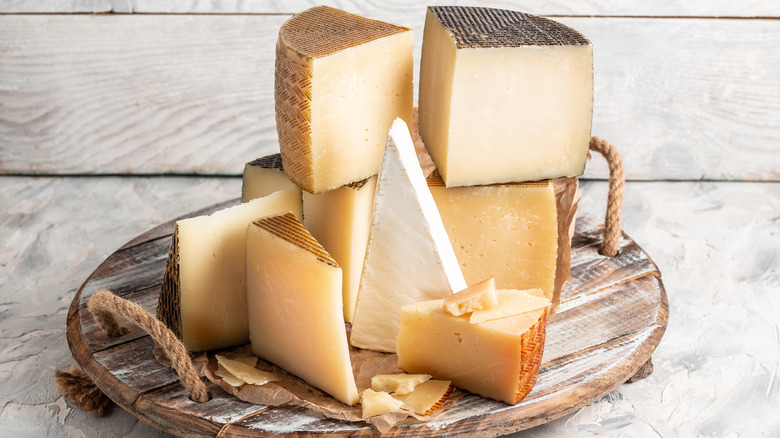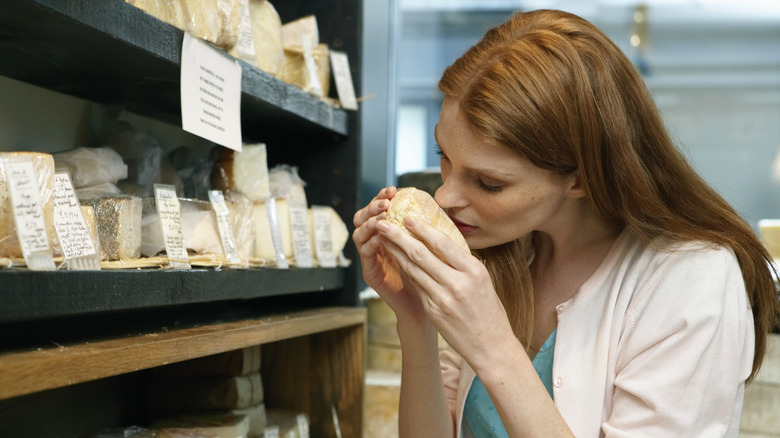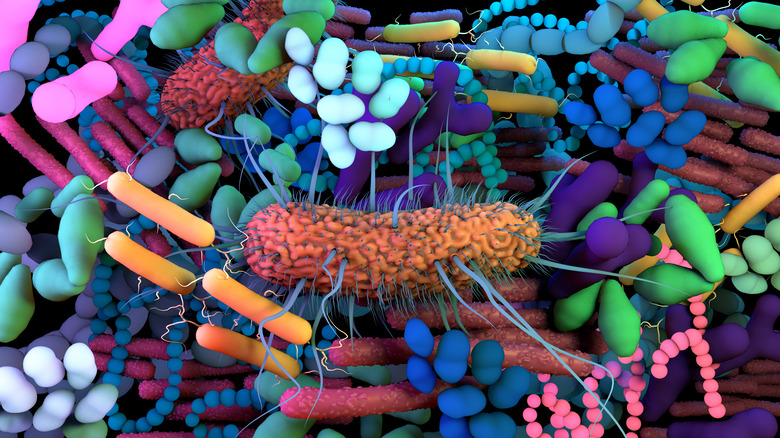A Bizarre London Museum Display Contains Cheese Made From Celebrity Bacteria
Just when you thought celebrity food culture couldn't get any stranger, it appears that some superstars have gone from cooking food to becoming it (via the Smithsonian Magazine). Cheesing for the cameras takes on a whole new meaning with the introduction of London's celeb-inspired museum display entitled, "FOOD: Bigger than the plate." According to Forbes, the curious culinary exhibition debuted in the Victoria and Albert Museum in October 2019 and was introduced as a gastronomic experiment in urban farming (more on that later).
What began as a fascinating deep dive into the oft-misunderstood world of microbes has morphed into heaping platters of human cheese created from the bacteria taken out of celebrity armpits, belly buttons, and toes. These peculiar plates are currently not for human consumption and will remain encased in museum glass to mesmerize (or nauseate) onlookers, at least for now.
But will the cheese of the future be crafted from bacteria dwelling on human skin? Will future diners be ordering a dish from their favorite pop idol's belly button gunk? The answer might surprise you.
Meet the celebs who are doing it for the culture -- literally
Forbes reports that the display cheeses were crafted from the bacteria of various British musicians. Notedly, the cast includes Alex James, the bassist for award-winning rock band Blur (pictured above), and multi-platinum-selling rap star Professor Green, who is currently signed to a label called Cooking Vinyl but claims to abhor the smell of cheese according to Smithsonian Magazine. Ska band Madness frontman Suggs also joined the lineup of famous faces.
Other stars that signed up to be fermented are 2013's Great British Bakeoff finalist Ruby Tandoh and celebrity chef Heston Blumenthal of "How To Cook Like Heston." Removing the word like and taking this concept to the lab was quite the feat. The stars were hauled off to have their belly button bacteria harvested and swapped out as starter culture for the cheese. The whole process begins with a skin swab and is completed as those bacteria grow inside a lab. Human cheese commentator Catherine Flood was quoted by Forbes, comparing the cheese to a kind of celebrity selfie because, "Once fully matured, each cheese will be a unique microbial portrait of the donor."
To that end, Professor Green's microbial portrait was mozzarella, Heston Blumenthal became comté cheese, Ruby Tandoh turned to stilton, Alex James became Cheshire cheese, and Madness singer Suggs was portrayed in cheddar.
The process of creating human cheese
Many people who participated in this experiment, including rapper Professor Green, have compared the stench of cheese to smelly feet. Smithsonian Magazine reports that as wacky as it sounds, the juxtaposition here is pretty accurate. As it turns out, the bacteria found on human skin is comparable to the bacteria used to make cheese from milk, so much so that these two materials are interchangeable, at least in theory.
Using human bacteria taken from armpits, belly buttons, ears, and noses theoretically creates a substance that certainly looks and smells like cheese. And this is not the only iteration of the concept. According to Healthline, breast milk has made the occasional impromptu appearance in several culinary dishes, including cheese as of late. Fortunately, at least for now, cooking human fluids is generally frowned upon, and for good reason. The concept of human cheese is more than icky. Some bodily fluids carry harmful pathogens and viruses. But as we move toward a future of sustainability, there's no denying that the underlying, dystopian-seeming, Soylent Green-esque aspect of this process which certainly toes the line between cheesy and cannibalism.
Human byproducts are being pitched in future-oriented projects and demonstrations
Before you write this culinary experiment off as just plain cheesy, it's worth noting the futuristic nature of the exhibit in which these platters were presented. The Victoria and Albert Museum, where the exhibit first appeared, described the exhibition as setting the stage for discussions about "how the collective choices we make can lead to a more sustainable, just and delicious food future." Furthermore, NDTV reports that laboratory workers are reviewing the human cheese sequences and strands to determine if the plates are safe enough to serve people in the future.
This is the gastronomic experiment in urban farming mentioned earlier in this article that could have some pretty eerie implications. According to Healthline, several supporters, including big-name nonprofits like PETA, are already signing off on the idea of utilizing human bacteria, byproducts, and waste in place of animal products in foods like cheese and ice cream. This opens up some pretty stomach-churning possibilities for "sustainable" food sources in the future. Will future foods be served straight out of a petri dish? Let's hope not.



